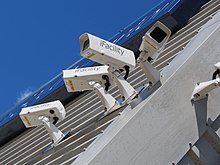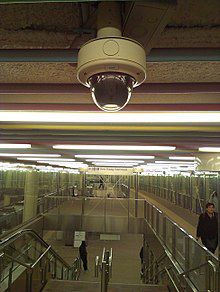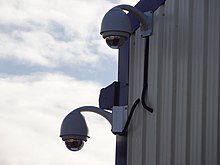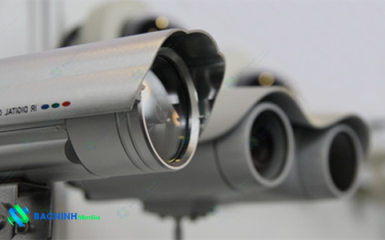“CCTV” redirects here. For the Chinese channel, see China Central Television. For other uses, see CCTV (disambiguation).
[columns][span4]
Surveillance cameras on the corner of a building.
[/span4][span4]
Dome camera in a rail station
[/span4][span4]
Dome CCTV cameras.
[/span4][/columns]Closed-Circuit Television (CCTV), also known as video surveillance, is the use of video cameras to transmit a signal to a specific place, on a limited set of monitors. It differs from broadcast television in that the signal is not openly transmitted, though it may employ point to point (P2P), point to multipoint (P2MP), or mesh wired or wireless links. Though almost all video cameras fit this definition, the term is most often applied to those used for surveillance in areas that may need monitoring such as banks, stores, and other areas where security is needed. Though Videotelephony is seldom called “CCTV” one exception is the use of video in distance education, where it is an important tool.
Surveillance of the public using CCTV is common in many areas around the world. In recent years, the use of body worn video cameras has been introduced as a new form of surveillance, often used in law enforcement, with cameras located on a police officer’s chest or head.[5] Video surveillance has generated significant debate about balancing its use with individuals’ right to privacy even when in public.
In industrial plants, CCTV equipment may be used to observe parts of a process from a central control room, for example when the environment is not suitable for humans. CCTV systems may operate continuously or only as required to monitor a particular event. A more advanced form of CCTV, utilizing digital video recorders (DVRs), provides recording for possibly many years, with a variety of quality and performance options and extra features (such as motion detection and email alerts). More recently, decentralized IP cameras, some equipped with megapixel sensors, support recording directly to network-attached storage devices, or internal flash for completely stand-alone operation.
There are about 350 million surveillance cameras worldwide as of 2016. About 65% of these cameras are installed in Asia. The growth of CCTV has been slowing in recent years.



😍 Liên hệ ngay với chúng tôi để nhận được tư vấn và hỗ trợ tốt nhất! 😍
Bắc Ninh Media
📞 Hotline: 0917658468 - 0222 6536789 - 02223875268
🌐 Website: https://bacninhmedia.com
🔗 Facebook: https://facebook.com/cameraquansatbacninh99
Bài viết liên quan
Dịch vụ Tin tức cập nhật
Lan Network System
Different Types of Networks There are many ways in which different networks can be classified, such as their...
Tin tức cập nhật
Thực hư thông tin tài xế bị phạt nguội gần 70 triệu đồng của tài xế Bắc Ninh
Một diễn đàn ô tô chia sẻ thông tin, tài xế taxi ở Bắc Ninh bị phạt nguội...
Tin tức cập nhật
Tổng đài mềm và tổng đài cứng có gì khác nhau?
Nói đến tổng đài hiện nay nó rất gần gũi với những câu nói quen thuộc như: tổng...
Công nghệ Tin tức cập nhật
Công nghệ cấp nguồn PoE là gì? chuẩn PoE ứng dụng trong camera quan sát
Chắc hẳn trong chúng ta đều đã dùng điện thoại bàn? Bạn có thắc mắc chúng hoạt động...
Dịch vụ Giải pháp Lắp đặt camera quan sát Tin tức cập nhật
Dịch vụ lắp đặt camera quan sát tại phường Châu Khê thị xã Từ Sơn
Dịch vụ địa chỉ cửa hàng công ty mua bán, cung cấp lắp đặt và phân phối Camera quan...
Tin tức nội bộ
Giao hữu bóng đá: Bắc Ninh Media và Bất động sản Tân Trang
Hấp dẫn, sôi nổi và không kém phần kịch tính là không khí của trận đấu giao lưu...
Dịch vụ Lắp đặt cửa từ cổng dò Tin tức cập nhật
Cổng chip chống trộm là gì? Vì sao cần lắp đặt cổng chip chống trôm?
Cổng chip chống trộm là thiết bị giúp đảm bảo an ninh cho các nơi như siêu...
Công nghệ Tin tức cập nhật
Tiêu chuẩn camera – xếp loại tiêu chuẩn IP trong camera quan sát
Tiêu chuẩn IP dùng để phân loại đánh giá mức độ bảo vệ của vỏ thiết bị an...
Dịch vụ Lắp đặt camera quan sát Tin tức cập nhật
Tăng cường an ninh tại các ngân hàng với camera an ninh Dahua
Ngân hàng là nơi diễn ra giao dịch tài chính với hàng triệu giao dịch mỗi ngày. Vì...